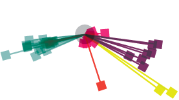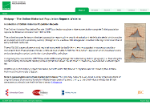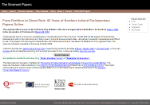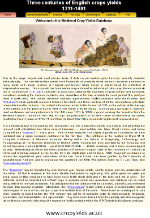2006-2007
The Online Historical Population Reports Website 1801-1937
http://www.histpop.org/
|
|
The OHPR website — histpop — is an online resource of almost 200,000 pages of all the published population reports created by the Registrars-General of and its predecessors for England and Wales and for Scotland for the period 1801–1920, including all Census Reports for the period 1801–1937, along with ancillary archival material from The National Archives, and critical essays contextualising much of the material. The whole resource will illustrate the changing demographic structure of Britain and Ireland over this period, and for the first time researchers will be able to search and browse the entire collection of published pre-World War Two census and registration material for the British Isles. histpop is the tangible output of the Online Historical Population Reports (OHPR) project which is run as a project within AHDS History at the UK Data Archive at the University of Essex. Funding for this project comes from the JISC Digitisation Programme. Including OHPR, there are six projects within this programme, the others being Eighteenth-century Parliamentary Papers, Archival Sound Recordings, British Newspapers 1800–1900, Medical Journals Backfiles and Newsfilm Online. Further details of these projects can be found at
http://www.jisc.ac.uk/publications/publications/pub_digi_tech_factsheet.aspx To enable access to this collection of material the histpop website offers browse and search facilities both of which can be refined to access the data by date and/or by geography. Browse and search results are presented in two stages. First, a table of contents of the original volume is displayed along with section titles. Users can drill through these sections to select the page they wish to view. The page is displayed as an image together with information about its location in the local hierarchy. Using this information, users can navigate to adjacent pages or to other levels in the volume or section hierarchy. Great emphasis has been put on contextualising the images in relation to their location in the source volumes hierarchy and in relation to other source material. For example over 150 historical essays, which have been written by Dr Edward Higgs and Dr Matthew Woollard, will accompany the site and can be accessed through search and browse as well as through an “Associated Content” feature when viewing an image. If an essay or essays are relevant to the page being viewed, then it will be able to be accessed as “Associated Content”. This principle applies to all resources where an association between essays (or primary legislation) and printed volumes exists. |
The Stormont Papers - 50 years of Northern Ireland Parliamentary Debates Online 1921-1972
http://stormontpapers.ahds.ac.uk/stormontpapers/
|
|
These papers cast a unique and valuable light on the development of the Province. The 92,000 printed pages of Parliamentary Debates are held by few institutions and they have no comprehensive subject index. Hence they have been inaccessible and difficult to use. This project, with the support of academics, archivists and politicians, has taken the Papers and fully digitised them. The resource has been available online since October 2006. The Stormont Papers consist of 84 volumes printed from the start of the Northern Irish Parliament in 1921 to the end of Home Rule in 1972. Based on the model of British Hansard, the papers record the utterances of MPs sitting at the Stormont Parliament within the (first) period of Home Rule in Northern Ireland. There are only few surviving sets of complete volumes and most can only be consulted within their relevant library. The volumes average roughly 1,100 pages per volume and each page has two columns of transcription. Beside the transcription, each volume has front matter (containing details of each of the Cabinet members, MPs and partliamentary officers for the year in question) and, at the back, an index of speakers, bills, etc. In total, there are around 92,000 pages and 74 million words. The task of digitising and delivering the Papers was divided between the Arts and Humanities Data Service Executive (based at King's College London) and the Centre for Data Digitisation and Analysis (based at Queen's University Belfast). The former focused on the technical architecture, data and content modelling, text mark up, indexing and delivery of the resource; the latter was responsible for the data capture work. |
Three Centuries of English Crops Yields 1211-1491
http://www.cropyields.ac.uk/
|
|
This is the single largest and most precise body of data on pre-modern grain harvests currently available internationally. The raw information comes from thousands of precisely dated manorial accounts preserved in many public and private archives in England and beyond which record in minute detail the cultivation of seigniorial demesnes. The accounts are hand written on parchment in abbreviated Latin using Roman numerals [for an example see “The data”] and state for each crop cultivated the quantities of grain seeded and harvested, sometimes including the medieval auditor’s own calculation of the rate at which the seed yielded (the yield per seed or yield ratio). The current database contains approximately 30,000 individual yield observations [see “Database”] which probably represent between two-thirds and three-quarters of all the observations potentially retrievable from the archives. The earliest information relates to the harvest of 1211 on the estates of the bishops of Winchester and the latest to that of 1491 on the estate of Battle Abbey. Chronological coverage is, however, most continuous and comprehensive for the 160-years 1270 to 1430, a period marking the transition from the Medieval Climatic Optimum to the Little Ice Age and punctuated by the worst crises of subsistence and public health (the Great Famine of 1315-21 and Black Death of 1347-50) in recorded English and European history. The “Database” may be searched by crop, harvest year, manor, estate, county, region, and any combination of the same. All that is required is that users identify themselves by registering. The yields given are yields per seed, gross of tithe (assumed to have been every tenth sheaf deducted in the field) and net of seed. The database cannot be amended but a “Wiki” page is available where any corrections and additions can be noted along with other relevant comments. It is anticipated that the database will be corrected, added to, and extended as more data become available. Meanwhile, the “Chronologies” facility offers a series of reconstructed annual chronologies for each of the principal crops and combinations of the same. These have no counterpart for any other country or period before the 19th century and will be of particular value to archaeologists, historians, economists, environmentalists, and agronomists. They have been derived from the spatially and chronologically discontinuous raw yield data using the regression facility available within the STATA statistical software package. |




